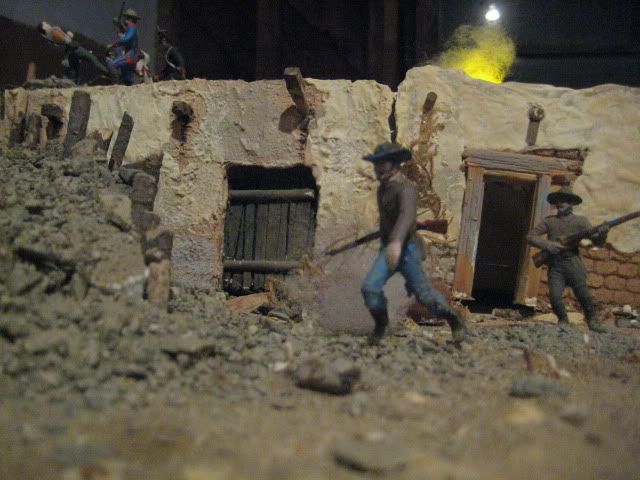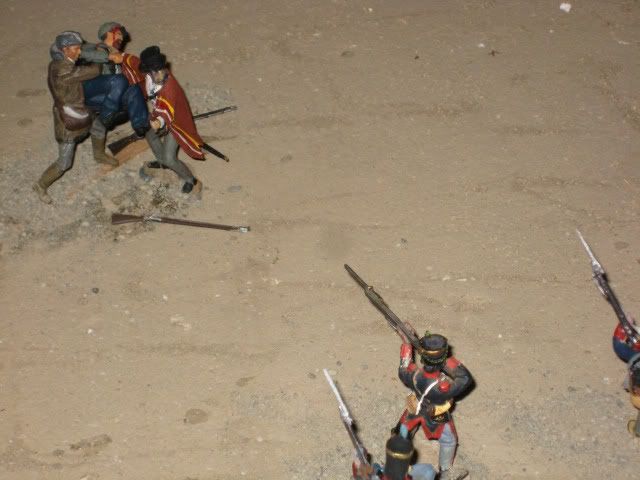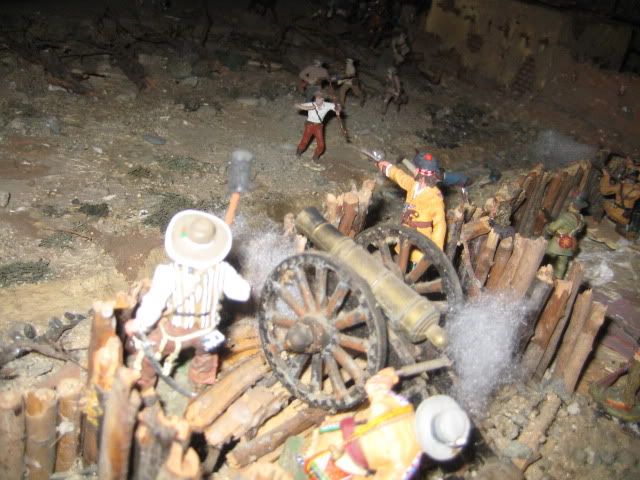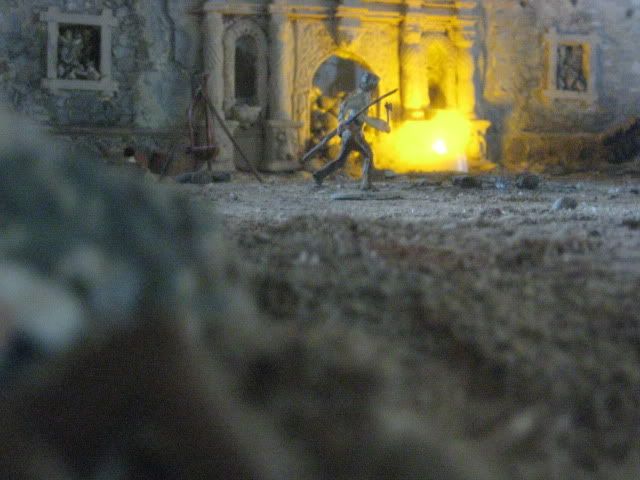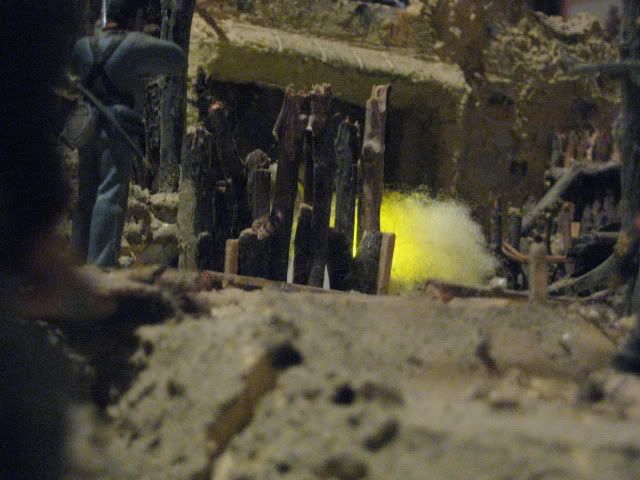You are using an out of date browser. It may not display this or other websites correctly.
You should upgrade or use an alternative browser.
You should upgrade or use an alternative browser.
Paul Lyon's Alamo (1 Viewer)
- Thread starter Paul J. Lyon
- Start date
Ghostrider
Specialist
- Joined
- Jan 13, 2009
- Messages
- 375
Paul - I thought the first 3 photos right below were stills from a movie set. This is real fine work. Very impressive
cheers
Joe
cheers
Joe
Paul J. Lyon
Private 2
- Joined
- Mar 19, 2010
- Messages
- 55
Thank you for all of your encouraging comments. I have been working on the East Wall side of the model for about a year now, preparing to seal it up into the corner where I wont be able to reach it again (the whole platform will be 15 X 12 feet).

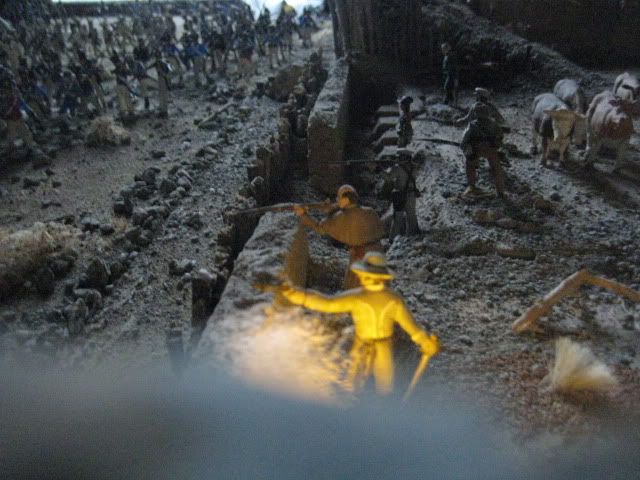
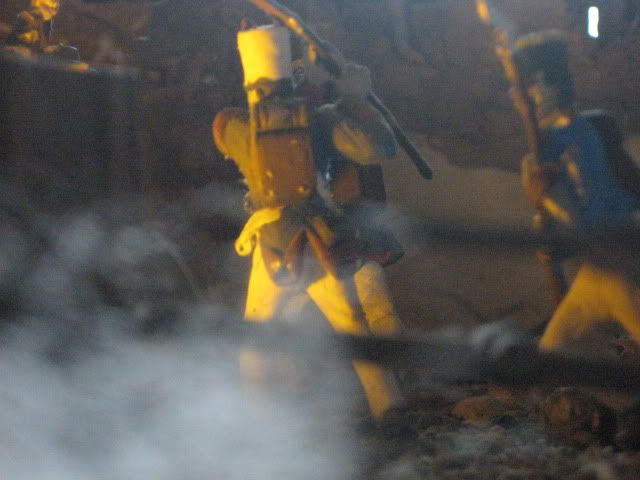
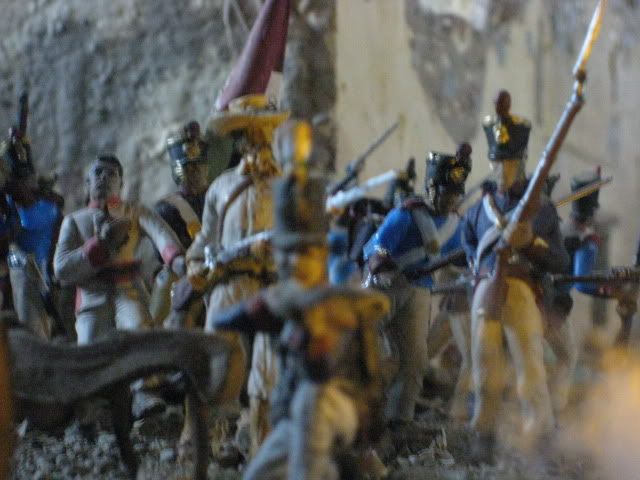
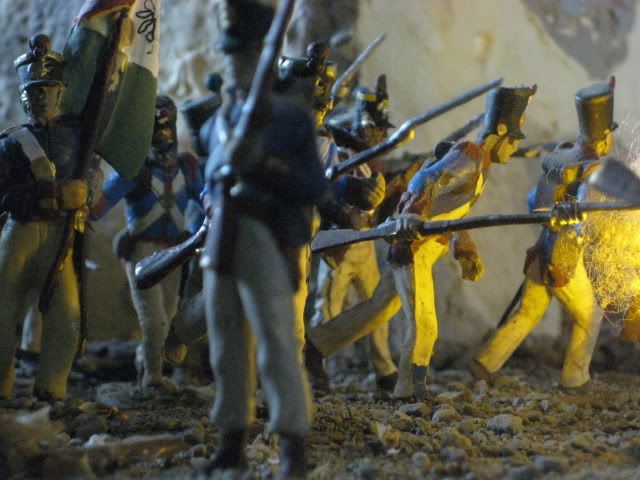
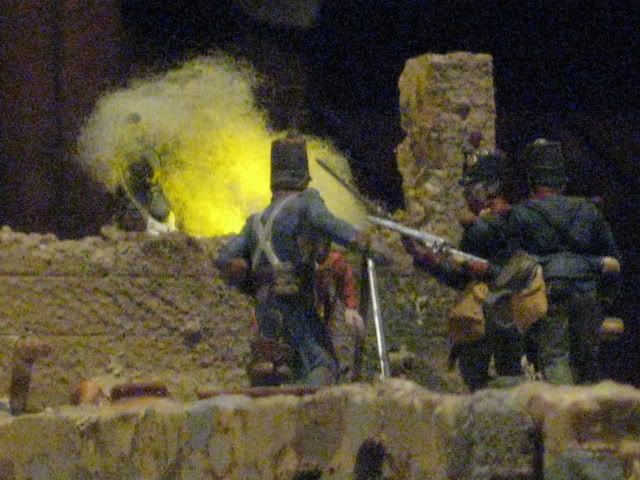
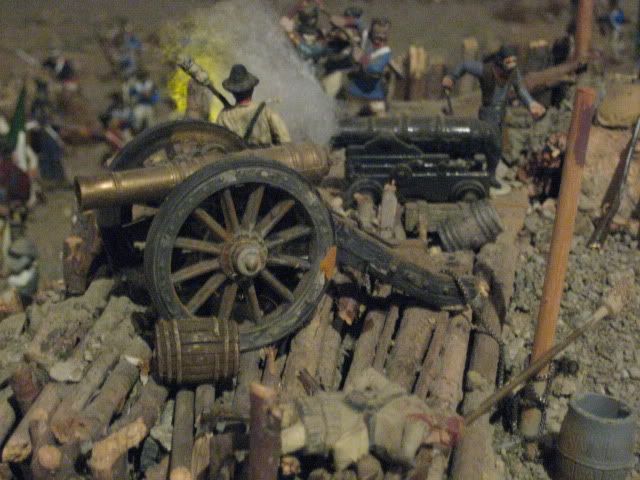











Ghostrider
Specialist
- Joined
- Jan 13, 2009
- Messages
- 375
Paul,
I no sooner get to compliment your work, and you immediately throw even more quality pics into the fight. I bow to your imaginative creativity sir. Oh! do I love the dio world. And 15'X12' you say!!!! Apparently you either live in a mansion, or your home living area is a dio. Whatever - keep it coming Paul, it looks so fine to me.
The best,
Joe
I no sooner get to compliment your work, and you immediately throw even more quality pics into the fight. I bow to your imaginative creativity sir. Oh! do I love the dio world. And 15'X12' you say!!!! Apparently you either live in a mansion, or your home living area is a dio. Whatever - keep it coming Paul, it looks so fine to me.
The best,
Joe
Paul J. Lyon
Private 2
- Joined
- Mar 19, 2010
- Messages
- 55
We have this big garage that was even bigger at first, then cut into two areas. The largest one is 20X 20, so I got that one.
The other one is full of tools you can't find, and is about 10' across. Eventually I'd like to open it back up.
I do live in a mansion, though-- at least by some standards. When I first walked up to the house I thought it was a duplex.
What I really want is the living room-- I swear I could put all of the Alamo battle and Bejar town there as well.
Thanks for the kind words.
The other one is full of tools you can't find, and is about 10' across. Eventually I'd like to open it back up.
I do live in a mansion, though-- at least by some standards. When I first walked up to the house I thought it was a duplex.
What I really want is the living room-- I swear I could put all of the Alamo battle and Bejar town there as well.
Thanks for the kind words.
Paul J. Lyon
Private 2
- Joined
- Mar 19, 2010
- Messages
- 55
Ghostrider
Specialist
- Joined
- Jan 13, 2009
- Messages
- 375
What I really want is the living room-- I swear I could put all of the Alamo battle and Bejar town there as well.
Boy, don't we all. You're real sharp with a camera also. I like those low angle shots. It creates that immersion effect I like.
Again, great work....
Joe
Last edited by a moderator:
Napoleon1er
2nd Lieutenant
- Joined
- Oct 11, 2010
- Messages
- 3,090
I can't express my opinion in words... simple stunning. Welcome to the forum, my name is Sandor, and I look forward to more of your incredible work!
My one pique is the Napoleonics. Though I am not very strongly opposed to their inclusion, a touch of paint on the uniforms wouldn't hurt
 :smile2:, and I saw one guy with a red uniform:wink2:^&grin....%^V
:smile2:, and I saw one guy with a red uniform:wink2:^&grin....%^V
But truly great!
-Sandor:salute::
My one pique is the Napoleonics. Though I am not very strongly opposed to their inclusion, a touch of paint on the uniforms wouldn't hurt
But truly great!
-Sandor:salute::
aujj65
Colonel
- Joined
- Sep 30, 2005
- Messages
- 9,153
I can't express my opinion in words... simple stunning. Welcome to the forum, my name is Sandor, and I look forward to more of your incredible work!
My one pique is the Napoleonics. Though I am not very strongly opposed to their inclusion, a touch of paint on the uniforms wouldn't hurt:smile2:, and I saw one guy with a red uniform:wink2:^&grin....%^V
But truly great!
-Sandor:salute::
There was a Mexican unit that had a red uniform if I'm not mistaken. :salute::
Jeff
Paul J. Lyon
Private 2
- Joined
- Mar 19, 2010
- Messages
- 55
It's almost an oxymoron to use the words "uniform" and "Mexican Army" together. The two main assigned uniforms consisted of cotton trousers and fatigue smock with a blue wool "overcoat," with white or buff crossbelts, for the regular infantry; and blue or gray wool coat and trousers with black crossbelts for the cazadores or rangers. The cavalry and lancers wore red, green, and blue according to some lost patterns or habits that I don't think can ever be reconstructed.
The epaulets, cuffs, and shako plumage tried to some extent to follow the regular color pattern for armies of the era, red, green, and yellow; according to the standard practice, the cazadores were considered the elite sharpshooters and some were equipped with the Baker rifle and sword bayonet. The evidence points to Santa Anna hoping to capture the fort before dawn with about 100 of these, many of whom slipped over the southwest angle before the surprise was blown.
Research done in the 1880s found that most regular Mexican troops at San Jacinto in April, 1836, were dressed in cotton fatigues rather than the common blue coat, and Santa Anna issued orders before the Alamo assault (March, 1836) that the soldiers were to leave their "overcoats and blankets" in camp. We don't know whether he meant the blue uniform coats or some additional coat worn over that, but this additional coat is not referred to as part of the ordinary soldier's kit.
The other problem is that many of the soldados were recently recruited or drafted and were poorly outfitted. Not many were given the full list of equipment or complete uniforms specified in the far capital. The prescribed uniform was a fiction drawn up for bureaucratic and funding purposes. The army was equipped with no medical supplies, regular reserve forces, or replacements for lost artillery, horses, or equipment.
It is likely that many of the men were wearing civilian clothing and sandals, straw hats, and didn't know how to maintain or properly use their weapons. It is true that Santa Anna ordered "raw recruits" to stay in camp, but it would have been difficult to identify and quarantine only those, especially in any 19th Century army with all of the shirkers. Besides that, the "reserves" were called up when they couldn't take the north wall-- 400 men, about half of them the elite zapadores (engineers). This means that the reserve column consisted of ill-shod and undisciplined rabble thrown in with upperclass educated troops in "big white hats" and wearing boots they didnt expect to have to mar in a doubletime march.
One of those engineers was an officer named de la Pena, and he held a grudge a long, long time.
The epaulets, cuffs, and shako plumage tried to some extent to follow the regular color pattern for armies of the era, red, green, and yellow; according to the standard practice, the cazadores were considered the elite sharpshooters and some were equipped with the Baker rifle and sword bayonet. The evidence points to Santa Anna hoping to capture the fort before dawn with about 100 of these, many of whom slipped over the southwest angle before the surprise was blown.
Research done in the 1880s found that most regular Mexican troops at San Jacinto in April, 1836, were dressed in cotton fatigues rather than the common blue coat, and Santa Anna issued orders before the Alamo assault (March, 1836) that the soldiers were to leave their "overcoats and blankets" in camp. We don't know whether he meant the blue uniform coats or some additional coat worn over that, but this additional coat is not referred to as part of the ordinary soldier's kit.
The other problem is that many of the soldados were recently recruited or drafted and were poorly outfitted. Not many were given the full list of equipment or complete uniforms specified in the far capital. The prescribed uniform was a fiction drawn up for bureaucratic and funding purposes. The army was equipped with no medical supplies, regular reserve forces, or replacements for lost artillery, horses, or equipment.
It is likely that many of the men were wearing civilian clothing and sandals, straw hats, and didn't know how to maintain or properly use their weapons. It is true that Santa Anna ordered "raw recruits" to stay in camp, but it would have been difficult to identify and quarantine only those, especially in any 19th Century army with all of the shirkers. Besides that, the "reserves" were called up when they couldn't take the north wall-- 400 men, about half of them the elite zapadores (engineers). This means that the reserve column consisted of ill-shod and undisciplined rabble thrown in with upperclass educated troops in "big white hats" and wearing boots they didnt expect to have to mar in a doubletime march.
One of those engineers was an officer named de la Pena, and he held a grudge a long, long time.
I agree about those low angle shots, excellent.
I also agree with Paul regarding any "uniform" desinations for the Mexixan army at the Alamo. I am doing the Alamo in 40mm, and it is very difficult to nail down anything when it comes to uniformed apperance. To me it seems like almost anything goes combination or styles of uniform were available. I like the John Wayne movie version as he threw in various styles of uniforms. Each of my Mexican assualt columns has a diffrenet combination of uniform which allows each unit to be easily identifed, and some may even be historically accurate. And some I did just becuase they looked good, and were "possibly" worn at some point. My interpretation is very flexible.
I also agree with Paul regarding any "uniform" desinations for the Mexixan army at the Alamo. I am doing the Alamo in 40mm, and it is very difficult to nail down anything when it comes to uniformed apperance. To me it seems like almost anything goes combination or styles of uniform were available. I like the John Wayne movie version as he threw in various styles of uniforms. Each of my Mexican assualt columns has a diffrenet combination of uniform which allows each unit to be easily identifed, and some may even be historically accurate. And some I did just becuase they looked good, and were "possibly" worn at some point. My interpretation is very flexible.
Napoleon1er
2nd Lieutenant
- Joined
- Oct 11, 2010
- Messages
- 3,090
It's almost an oxymoron to use the words "uniform" and "Mexican Army" together. The two main assigned uniforms consisted of cotton trousers and fatigue smock with a blue wool "overcoat," with white or buff crossbelts, for the regular infantry; and blue or gray wool coat and trousers with black crossbelts for the cazadores or rangers. The cavalry and lancers wore red, green, and blue according to some lost patterns or habits that I don't think can ever be reconstructed.
The epaulets, cuffs, and shako plumage tried to some extent to follow the regular color pattern for armies of the era, red, green, and yellow; according to the standard practice, the cazadores were considered the elite sharpshooters and some were equipped with the Baker rifle and sword bayonet. The evidence points to Santa Anna hoping to capture the fort before dawn with about 100 of these, many of whom slipped over the southwest angle before the surprise was blown.
Research done in the 1880s found that most regular Mexican troops at San Jacinto in April, 1836, were dressed in cotton fatigues rather than the common blue coat, and Santa Anna issued orders before the Alamo assault (March, 1836) that the soldiers were to leave their "overcoats and blankets" in camp. We don't know whether he meant the blue uniform coats or some additional coat worn over that, but this additional coat is not referred to as part of the ordinary soldier's kit.
The other problem is that many of the soldados were recently recruited or drafted and were poorly outfitted. Not many were given the full list of equipment or complete uniforms specified in the far capital. The prescribed uniform was a fiction drawn up for bureaucratic and funding purposes. The army was equipped with no medical supplies, regular reserve forces, or replacements for lost artillery, horses, or equipment.
It is likely that many of the men were wearing civilian clothing and sandals, straw hats, and didn't know how to maintain or properly use their weapons. It is true that Santa Anna ordered "raw recruits" to stay in camp, but it would have been difficult to identify and quarantine only those, especially in any 19th Century army with all of the shirkers. Besides that, the "reserves" were called up when they couldn't take the north wall-- 400 men, about half of them the elite zapadores (engineers). This means that the reserve column consisted of ill-shod and undisciplined rabble thrown in with upperclass educated troops in "big white hats" and wearing boots they didnt expect to have to mar in a doubletime march.
One of those engineers was an officer named de la Pena, and he held a grudge a long, long time.
Well, as they say- ignorant me^&grin! I have to say, though... the figures you painted are 10 times better looking and accurate then any of the "imposters"^&grin
By the way, could we get some aerial pics of the whole thing?
Thanks,
Sandor
Paul J. Lyon
Private 2
- Joined
- Mar 19, 2010
- Messages
- 55
I'm sorry to sound like a know-it-all. I've had bad experiences on the net with bitter arguments about the Alamo. Believe it or not, the worst fight I had with someone was about whether there was a doorway in the connecting wall running from the church to the convent!
I really appreciate the reception here and I'll try in the future not to be that way.


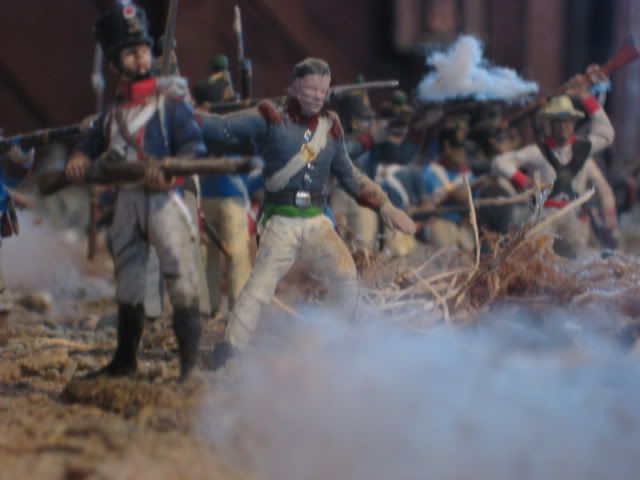




I really appreciate the reception here and I'll try in the future not to be that way.







Paul J. Lyon
Private 2
- Joined
- Mar 19, 2010
- Messages
- 55
marco55
Brigadier General
- Joined
- Feb 18, 2008
- Messages
- 11,608
Simply awesome.I love super dios.All the time and effort you put into this,this must be surely a labor of love.Did you ever see Thomas Feely's Alamo?I believe it is a museum in San Antonio.You can see pictures of it at www.historicalminiatures.net
Again well done.
Mark
Again well done.
Mark
Napoleon1er
2nd Lieutenant
- Joined
- Oct 11, 2010
- Messages
- 3,090
This should totally be in the Alimo museum!
-Sandor
P.S. I just to make my previous statements more clear- I love everything about Paul's diorama, I was simply praising his homade figures over the others! Sorry for any misunderstanding.
-Sandor
P.S. I just to make my previous statements more clear- I love everything about Paul's diorama, I was simply praising his homade figures over the others! Sorry for any misunderstanding.
Paul J. Lyon
Private 2
- Joined
- Mar 19, 2010
- Messages
- 55
I had the whole thing open in the middle for months so I can reach everything, and now have the perimeter up. You can really get a sense of why they couldn't defend that big a place with so few men.
I want to put it all up in temporary mode and take longer shots. Also, I'd like to Photoshop in background landscape, and I am getting the knack for it.
I managed to field an entire Mexican column of 400 out behind the fort. The cats get into the garage and use the sacred battlefield for a catbox, so I now have to install new doorhandles and latches. Defending the Alamo never ends.
Feely's model is pretty incredible. I saw pictures of it when it was set up in some sort of giant barn. It turns out that there are a number of people around the country who have Alamo dioramas set up in their basements, garages, barns. I encourage everyone to do it, and many on this site have one. It inspires the manufacturers to make more poses of Mexican soldiers.
I have a huge gripe against the standard poses, particularly the shooters and flagbearers. Conte makes so many of these that it cripples the army!
It's very hard to alter some of these. If you buy all of the Mexican poses from Conte, you end up with way too many, while some of the other more adaptable ones are too few. This is a serious problem, since you try with a diorama to fool the audience into seeing a different individual with every figure.
I want to put it all up in temporary mode and take longer shots. Also, I'd like to Photoshop in background landscape, and I am getting the knack for it.
I managed to field an entire Mexican column of 400 out behind the fort. The cats get into the garage and use the sacred battlefield for a catbox, so I now have to install new doorhandles and latches. Defending the Alamo never ends.
Feely's model is pretty incredible. I saw pictures of it when it was set up in some sort of giant barn. It turns out that there are a number of people around the country who have Alamo dioramas set up in their basements, garages, barns. I encourage everyone to do it, and many on this site have one. It inspires the manufacturers to make more poses of Mexican soldiers.
I have a huge gripe against the standard poses, particularly the shooters and flagbearers. Conte makes so many of these that it cripples the army!
It's very hard to alter some of these. If you buy all of the Mexican poses from Conte, you end up with way too many, while some of the other more adaptable ones are too few. This is a serious problem, since you try with a diorama to fool the audience into seeing a different individual with every figure.
Users who are viewing this thread
Total: 2 (members: 0, guests: 2)


